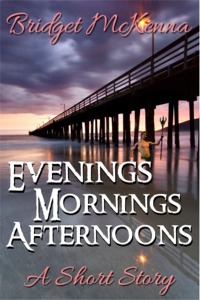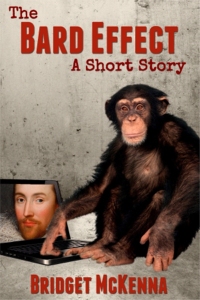
As I've been republishing these works of short fiction that appeared in science fiction magazines some years back, I've been writing afterwords that tell something of how I came to write the story. When I was ready to republish this one, I realized the afterword was far too short and contained far too little. So I started over and told more of the story behind the story.
In keeping with my recent habit of providing the afterword to each new publication here, in addition to inside the very-reasonably-priced book itself, what follows this paragraph is the afterword to “Hole in the Wall,” which you can read even if you’re not going to shell out 99c, though of course I would never try to stop you from doing that too.
Writing Hole in the Wall
When I first got the idea for “Hole in the Wall,” I didn’t know what I was going to do with it. I knew the story took place in a diner, and in the diner was a wall with a portal that went somewhere. So I had a setting, but not yet a story. Later I decided the man who ran the diner was called Tomacheski, who was a recent immigrant. Now I had a setting with a character. And there it languished. In those days, or so it seemed to me at the time, some of my ideas became fully-realized stories, and others did not; I had no clue as to why. I was still a bit new to this writing lark, and although I'd made a couple of fiction sales, the whole process seemed more like luck to me than craft.
Eventually, luck took me far enough that I could absorb the craft I needed. I met Algis Budrys, who was then the editorial director for the Writers of the Future contest. On the night we met, at a party attended by quite a few starry-eyed wannabe science fiction and fantasy writers, he shared with us the seven-point plot skeleton that he claimed was the inner structure of every story. You would not find it in vignettes or stream-of-consciousness pieces, he said, but whether the author knew it was there or not, it served as the bones of every story with a beginning, a middle, and an end, and knowing how to apply it was an important key to stories that worked.
I didn't yet know whether that was true, and I didn’t yet know how basic the structure of narrative is to human consciousness, but I took it on faith. I consciously applied the model to the next story I wrote, and the next, and the next. I sent these stories off to Writers of the Future, in three successive quarters. I received honorable mentions for the first two, which was wonderful encouragement, especially as some of the most amazing writers of the time were judging: Anne McCaffrey, Roger Zelazny, Larry Niven, and Gene Wolfe were among the judges that year. I felt there was a distinct possibility I might be doing something right.
I've since found the seven plot structure elements Algis revealed to me that night in every story I've ever examined, no matter how commercial or how high-flown and literary, though many writers will still tell you the structure doesn't exist, and others confuse plot with formula. Algis used to say "Formula is putting Coke™ in a Coke bottle for Coke drinkers. Plot is the structure of the events in your story. Storyline is what happens to your character as a result of those events." Years later, a writer who's won every award I ever lost and a few more rapped my knuckles thoroughly when I wrote an article about seven-point plot structure for a writers' magazine, and warned anyone reading his commentary that I was peddling claptrap. You can see that opinions differ sharply on this subject.
So back to the evening in December 1985, when I got a phone call at the bookstore I managed in Redding, California. It was from the WotF contest director, who informed me I had won first prize for the fourth quarter of that year for my story "The Old Organ Trail." We talked for a few minutes while my feet tried in vain to find the floor; he seemed as pleased to be giving the news as I was to be receiving it. After he'd hung up I remember thinking “I must have mis-heard him. He probably said third place.” Fortunately, that was just my insecurity trying to keep me from getting my hopes up. It was first place, and I got a really nice check for the win, and another when Algis bought the story for the annual anthology at an unheard-of word rate for an unknown writer.
A few months later, I was invited to a week-long workshop in Taos, New Mexico. This was the first Writers of the Future workshop—a test case to see if the idea would work. The workshop was held in May, 1986. There, four of the greats of science fiction—Frederik Pohl, Gene Wolfe, Jack Williamson, and Algis Budrys himself—did their best to teach eleven new writers (including Dean Wesley Smith and Kristine Kathryn Rusch, whose blogs you should be reading if you don’t already) how to turn an idea into a story, and how to make the story shine once you’ve written it. “First you write it, then you make it good!” was a piece of memorable advice from Fred Pohl that should probably be tattooed on every new writer.
As the workshop progressed, and I learned more about the structure of stories, I began to think of the ones I’d begun, then abandoned in old notebooks because I had no idea how to complete them. I had loosely plotted two of them by the time I got home and went looking for those notebooks. "Hole in the Wall" was one of the stories I dug up that year, and eventually finished.
Early on in outlining the story (yes, I do outline—no, I don’t always stick to the outline), I was having difficulty bringing the narrative alive. I realized I needed to make a change in the my choice of viewpoint characters. Ladislaw Tomacheski was the hero of my story, but the more I thought about it, the more I felt I needed to tell it from Morton Grimes’ viewpoint.
As Tomacheski’s story, it would tell of the triumph of the little guy over a corrupt system which Grimes would personify; potentially interesting and fun, but I felt like I was missing something.
Morton Grimes’ story is about a man who's so tied up in his own narrow ideology that he can't recognize good people when he meets them, and never seems to be on the side of the angels in any situation. In the end, he loses his last and best chance to change. As Grimes’ story, “Hole in the Wall” could relate the same basic events with the same humor, but Grimes’ overpowering sense of justification and lack of human understanding would be clearer, and the underlying tragedy would make itself felt. The story felt stronger and more meaningful to me this way. Having made that decision, the writing became much easier; the story had found its voice.
Shortly before I sent this story to Gardner Dozois at Asimov’s, I sent him a novelette-length time travel story. He said he thought it was a good story, but was going to turn it down. In general, he said, time travel stories didn’t make a lot of sense to him.
I put that one aside, and sent him the very next thing down on my stack, which was…yep…another time travel story. I didn’t realize this until after I’d mailed it, and so resigned myself to getting it back shortly. Fortunately, Gardner liked this one enough to write a check. “Hole in the Wall” appeared in Asimov’s in May 1991, and again in Timegates, (Ace Science Fiction, edited by Gardner Dozois and Jack Dann), in 1997. Thanks Gardner, and thanks Jack, and thanks to all you readers out there.













 RSS Feed
RSS Feed




